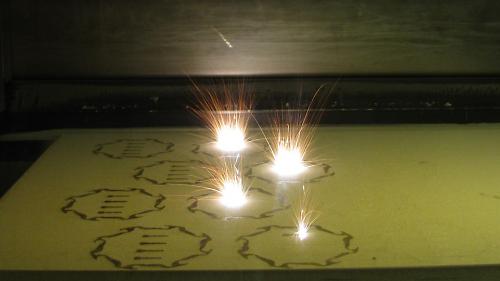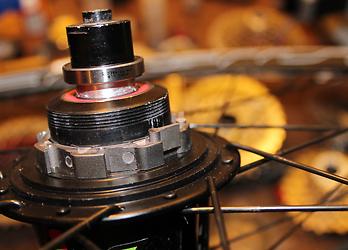- News
- Reviews
- Bikes
- Accessories
- Accessories - misc
- Computer mounts
- Bags
- Bar ends
- Bike bags & cases
- Bottle cages
- Bottles
- Cameras
- Car racks
- Child seats
- Computers
- Glasses
- GPS units
- Helmets
- Lights - front
- Lights - rear
- Lights - sets
- Locks
- Mirrors
- Mudguards
- Racks
- Pumps & CO2 inflators
- Puncture kits
- Reflectives
- Smart watches
- Stands and racks
- Trailers
- Clothing
- Components
- Bar tape & grips
- Bottom brackets
- Brake & gear cables
- Brake & STI levers
- Brake pads & spares
- Brakes
- Cassettes & freewheels
- Chains
- Chainsets & chainrings
- Derailleurs - front
- Derailleurs - rear
- Forks
- Gear levers & shifters
- Groupsets
- Handlebars & extensions
- Headsets
- Hubs
- Inner tubes
- Pedals
- Quick releases & skewers
- Saddles
- Seatposts
- Stems
- Wheels
- Tyres
- Health, fitness and nutrition
- Tools and workshop
- Miscellaneous
- Tubeless valves
- Buyers Guides
- Features
- Forum
- Recommends
- Podcast
TECH NEWS
Revolutionary Kappius hubs use 3D printing process + video
All great inventions come about as a solution to a problem. Tullio Campagnolo invented the quick release skewer out of frustration at the wingnuts that used to hold bicycle wheels in the frame. And so Colorado-based Russel Kappius has developed a new hub design after his friend’s bike hub failed on a long ride, resulting in a long walk home.
With his engineer's hat on, he started working on a a solution, and developed a hub with a large shell and wider bearing spacing and larger freehub mechanism. 240 engagement points drastically reduces the pickup time, that slight delay when you push on the pedals and the freehub engages. His design is based on a larger hub design which allows for better bearing placement, and is easier to maintain and is lighter, he claims.
When it came to manufacturing he found traditional methods too expensive and too slow, with a turnaround time of months. So he hit upon using 3D printing, more specifically direct metal laser sintering (DMLS). 3D printing is one of the newest and most exciting manufacturing developments in recent years, and involves a laser melting layer upon layer of metal powder. Using 3D printing produced much quicker turnaround times of just a matter of weeks of prototypes, and was a lot less expensive.

It’s a manufacturing process gaining popularity quickly, and we’ve featured a few examples on road.cc previously. There was the Bristol-based company’s space-age Nylon bike a couple of years ago, and the same company more recently printed titanium dropouts for Charge Bikes, who used them in a limited run of cyclocross frames.

Since then he’s formed Kappius Components and his hubs have become desirable, most famously ridden by Swiss mountain bike champion Christoph Sauser.
“Having folks from around the world chase me down and saying I really believe in what you’re doing, I want to support you…[Sauser] sent me an email that dropped me to the floor. He’s one of the biggest names in cycling and the second sentence he said to me was, ‘I think your hub is the best.’ That’s pretty flattering – humbling too.”

The first hub, the KH1, uses oversized design, twice that of a regular hub, with many more points of engagement. This means the pedal can engage every 1.5 degrees. But it’s only compatibale with cassettes they modify to work with the hub. A bit of drawback. The second hub, KH2, solves this problem, being compatible with regular cassettes. It's currently on Kickstarter, take a look here.

He’s not only working on a second generation hub, but also taking a look at the rest of the wheel, with the rim in his sights. They plan to bring to market they own wheel design in the near future.

“The tyre I’m not going to really touch right now, but the rim I am…the rim is something I think we can do way better, you look at the way F1 cars work, they use carbon fibre – I think there’s a lot of things we can offer there – and then eventually the entire drive train.”
This is just the start, Kappius reckons the whole bicycle could one day be produced entirely using the 3D printing process. The cost of the manufacturing process will come down and there will be more small firms popping up, and there’s even the possibility of buying 3D printers for your home.
Find out more at www.kappiuscomponents.com
David worked on the road.cc tech team from 2012-2020. Previously he was editor of Bikemagic.com and before that staff writer at RCUK. He's a seasoned cyclist of all disciplines, from road to mountain biking, touring to cyclo-cross, he only wishes he had time to ride them all. He's mildly competitive, though he'll never admit it, and is a frequent road racer but is too lazy to do really well. He currently resides in the Cotswolds, and you can now find him over on his own YouTube channel David Arthur - Just Ride Bikes.
Latest Comments
- mark1a 4 hours 13 min ago
Easy to say, but who made the devices you are using to say this?...
- lonpfrb 6 hours 13 min ago
He has misogynistic form for calling women of intellect and integrity; Attorneys General, Judges, Bishops, 'Nasty' since the narcissistic sociopath...
- Freddy56 6 hours 18 min ago
I have a 10 year old set of shamals and a 20 TWENTY! year old set of Zondas still going strong.
- Freddy56 6 hours 19 min ago
I have these in the photochromic option for winter and they are light and fast acting. Happy with the purchase.
- Rendel Harris 7 hours 44 sec ago
Do enlighten us with yours. If you think that refusing to take the British national women's champion to compete in the class in which she is...
- Simon E 7 hours 24 min ago
Not forgetting the 5p 'temporary' cut in 2022, resulting in an estimated £3 billion of lost revenue each year....
- ChrisA 9 hours 2 min ago
You want solar panels? Yours for €1659. https://widepathcamper.com/spare-part/428629/solar-cell-kit-complete-wit...
- Beachboy 9 hours 40 min ago
If you want to see a real demonstration, albeit on social media from kick ball fans, tell them you are keeping the trees but making the road a...
- CyclingGardener 10 hours 29 min ago
My very first LED front light - a present, so possibly expensive - proudly stated that it was visible half a mile away or something, then in the...








Add new comment
7 comments
F1 cars do not use carbon in wheel rims. It's forbidden in the regulations.
As far as I'm aware 3D printing was used only to make some small parts (paws?) not the whole hub.
Can we also please stop this misleading 3D printing "revolution" nonsense?
There is nothing revolutionary, new or magical about it.
It's just one of the ways of making things (with its limitations) but in vast majority of cases uneconomical for anything other than testing and prototyping comparing to e.g. machining.
I beg to differ. It is revolutionary because it is the exact opposite way of manufacturing we have done for the last 200 years. WHEN additive manufacturing is economical enough to be utulised in consumer design it will radically change design and engineering principles and give designers and engineers a lot more freedom in design and manufacturing.
WHEN... it happens, it'll be still just another production method with its advantages and drawbacks.
It won't change the world we live in, as some overenthusiastically claim.
But if/when...
one day the technology becomes so good that most of people will be able to make e.g. bicycle parts at home it may paradoxically become a killer of progress and innovation.
One day you launch a brilliant product, next week someone reverse engineers it and uploads the CAD file on a torrent website for anyone to download and print it without paying you a single penny...
That would be a revolution, indeed.
So will the freehub be louder?
That would be a main selling point.
Chris used to be King of the engagement game so this isn't radical and people complained about the noise of CK hubs, i quite liked it.
How much does this weigh, it seems that printing is a great way to save off a few grams.
it's official - 3D Printed is the new CNC machined. As for forging, that is so 20th Century?